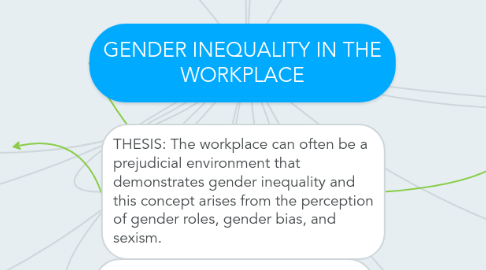GENDER INEQUALITY IN THE WORKPLACE
Sarina Nathooにより

1. THESIS: The workplace can often be a prejudicial environment that demonstrates gender inequality and this concept arises from the perception of gender roles, gender bias, and sexism.
2. Gender inequality is a major factor in the workplace that result in women having to work ten times harder to keep up with a male as well as deal with the stereotypes implicated.
3. GENDER ROLES: cultural norms that determine a role or position for a gender.
4. GENDER BIAS: cultural norms that create a prejudicial attitudes towards a certain gender.
5. Only 26,000 out of 8,000,000 women in the workforce were deemed fit enough to obtain a management position.
6. Females continue to be primary caregivers but cannot do so and give 16 hours a day 7 days a week to maintain a full time job as well.
7. Men on average get 1.5 more vacation days than women yet women use more of the vacation days than men
8. Effective leaders are displayed as strong, powerful individuals. If a women displays these traits they are portrayed as aggressive and abrasive but if they are sympathetic and nurturing they are considered weak.
9. Women are told to be modest and self-effacing team players that are happy to do office housework. If not they are shown to not be a team player.
10. The workforce needs to ensure females receive equal opportunities as men and in years to come society must work towards the belief of feminism to secure the same rights for all who have earned it.
11. 1. What do you think created these stereotypes in the workforce? 2. Do you think these statistics and this treatment of women will change in the future? 3. Why do you think this still occurs even if this topic is brought up on a day to day basis? 4. Do you agree with the way women are perceived in the workplace? Why? 5. Do you think this applies to every women in the workforce? 6. Could gender inequality in the workplace apply to men as well? How? 7. What solutions do you propose that can change this ordeal?
12. Gender inequality refers to the unequal treatment or ideology of a certain gender.
13. SEXISM: stereotyping or being discriminatory towards a gender; typically females.
14. Women make up 48% of the work force but only 8% of them have senior management positions.
15. To naturally reproduce a population the fertility rate has to be 2.1, but in most first world countries, the rate is between 1.3 and 1.9.
16. Majority of women saw themselves as EQUALLY CAPABLE as their colleague but majority of men considered themselves MORE CAPABLE than their counterpart.
17. If a man stayed late his favourability was enhanced by 14% but if both male and female workers declined to stay late only the women's favourability decreased by 12%.
18. Women often do a "second-shift" of housework and childcare when they return home. This results in them waiting longer for partnership.


